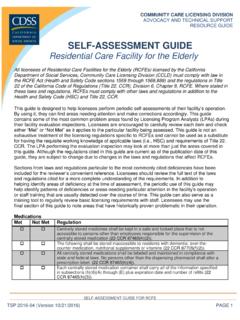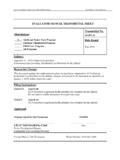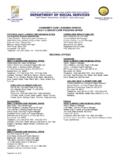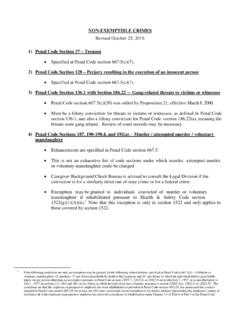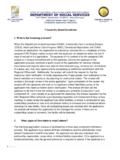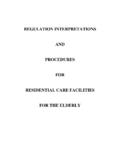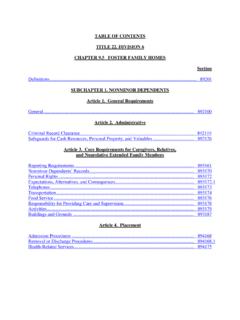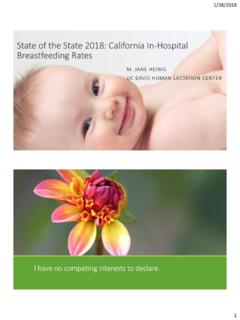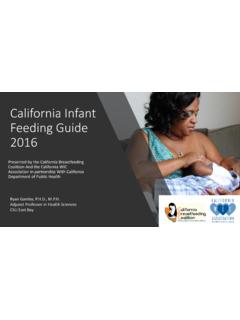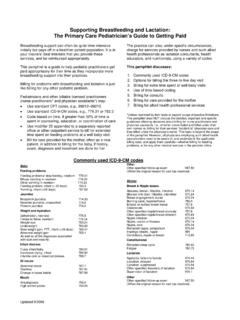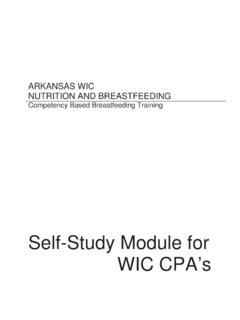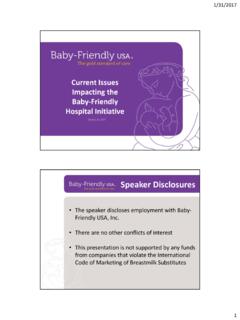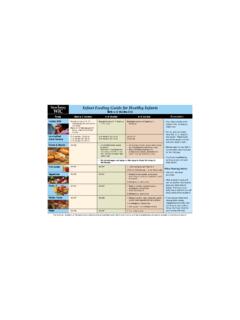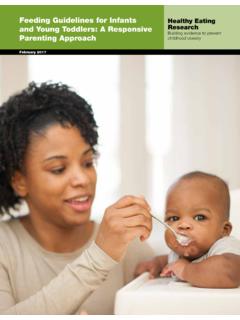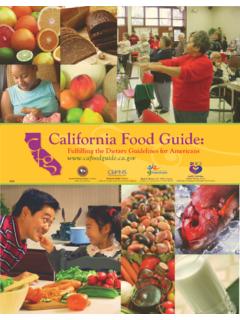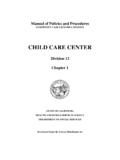Transcription of CHILD CARE CENTER SELF ASSESSMENT GUIDE SAFE ... - …
1 California Department of Social Services CHILD care CENTER self ASSESSMENT GUIDE SAFE FOOD HANDLING AND PREPARATION LICENSING REQUIREMENTS AND BEST PRACTICES COMMUNITY care LICENSING DIVISION Promoting Healthy, Safe and CHILD care Advocate Program 2 CCAP 04/17/01 Supportive Community care CHILD care CENTER self - ASSESSMENT GUIDE SAFE FOOD HANDLING AND PREPARATION LICENSING REQUIREMENTS AND BEST PRACTICES Safe practices in food handling, cooking, and storage are essential to prevent food borne illness and for providing healthy food for children. This GUIDE identifies licensing requirements for food handling and provides some best practices to help prevent food from spreading illness to you, your staff and the children in care . We encourage you to use the GUIDE to periodically assess the practices used in your CENTER to ensure safe food handling and preparation.
2 Food safety practices that are required by the CHILD care CENTER Home regulations are noted with the regulation section in parentheses. CHILD care facilities are exempt from the requirements of the California Uniform Retail Food Facilities Law (Health and Safety Code, Division 104, Part 7, Chapter 4). At the back of the GUIDE , we have attached charts on food cooking temperatures and food cold storage that can help you ensure safe cooking and storage of food in your CHILD care CENTER . SAFE SHOPPING Do not buy or use meat, poultry and meat products unless they have been inspected. (Section 101227) Do not use or buy home canned food from outside sources, food from dented, rusted, bulging, or leaking cans, or food from cans without labels. (Section 101227) Do not buy or use raw or non-pasteurized milk or milk products, or non-pasteurized juices.
3 (Section 101227) Place frozen food and perishables such as meat, poultry or fish in plastic bags and put them in the shopping cart last. Do not buy torn or leaking packages. Do not buy foods past sell-by or expiration dates. SAFE STORAGE OF FOODS Keep your refrigerator and freezer clean and in safe condition. (Section 101227) 3 CCAP 04/17/01 Store soaps, detergents, cleaning compounds or similar substances away from food supplies to prevent accidental poisoning, potential leakage problems, and contamination. Always keep these substances away from children. (Section 101227) Do not store pesticides and other similar toxic substances where you store, cook or prepare food, or where you store kitchen equipment or utensils. Always keep these substances away from children.
4 (Section 101227) Unpack perishable foods from the car first and put them in the refrigerator right away. Keep the refrigerator temperature at 40 F or less, and the freezer at 0 F, to slow the growth of most bacteria and keep them from multiplying. Check the temperature of your refrigerator and freezer daily with an appliance thermometer. Keep all food stored in the refrigerator and freezer covered, wrapped, stored in airtight containers, or otherwise protected from contamination. Wrap raw meat, poultry, and seafood securely to prevent raw juices from contaminating other foods. Store them in the meat drawer or coldest section of the refrigerator or freezer. Do not store perishable foods, such as eggs, in the refrigerator door. The temperature of storage bins in the door fluctuates more than the temperature in the cabinet.
5 Cook or freeze fresh poultry, fish, ground meat, and mixed meats within 2 days after you buy them. Cook or freeze other beef, veal, lamb or pork within 3 to 5 days. Store food that does not need refrigeration in a way to keep insects and rodents from entering the food. For example, keep storage containers off the floor. Store dry, bulk foods that are not in their original, unopened containers off the floor in clean metal, glass, or food grade plastic containers with tight fitting covers. Label and date the containers. Keep storerooms clean, dry, well ventilated, and cool (about 60 F). FOOD BROUGHT FROM HOME Label breast milk with the infant s name and date, and refrigerate or freeze it right away. (Section 101427) Label food brought by parents with the CHILD s name and date, and store it in the refrigerator when needed.
6 4 CCAP 04/17/01 Do not give food brought from one CHILD s home to another CHILD . Never give breast milk intended for one infant to another infant . Do not store breast milk, unless already frozen, overnight. Always send unused breast milk home with the infant . Do not store defrosted breast milk for more than 12 hours. Never refreeze breast milk. Throw away bottles of formula or breast milk that are not finished after a feeding . Do not refrigerate, reheat or serve them again. SAFE FOOD PREPARATION Keep all kitchen equipment, dishes, and utensils clean and in safe condition. (Section 101227) Wash dishes and eating and serving utensils in a dishwasher (reach a temperature of 165 F during the washing or drying cycle) or by hand with a sanitizing agent. (Section 101227) Keep the food preparation area separate from the eating, napping, play, toilet and bathroom areas, and from areas where animals are kept.
7 Never use the food preparation area as a passageway while food is being prepared. (Section 101227) Make sure that all staff wash their hands before preparing food, serving and eating meals and snacks, and after toileting, diapering and outdoor activities. The best way to combat the spread of communicable disease or germs is by careful handwashing with liquid soap, rinsing under running water, and drying with paper towels. Do not wash hands in food preparation sinks to prevent contamination of food. Keep all surfaces that come in contact with food (including tables and countertops), floors, and shelving in good repair. Use smooth and nonporous materials that are easily cleaned and sanitized. Use cutting boards that can be disinfected (such as glass, Formica, or plastic). Always clean them with soap and hot water after each use.
8 Do not use cutting boards with crevices and cuts because they can hide food material that can grow bacteria and contaminate the next food cut on the surface. Always clean and sanitize cutting boards, knives and other utensils after they come in contact with raw meat, poultry and seafood. Use one cutting board for raw meat products and another for salads and ready-to-eat foods to prevent cross contamination of bacteria from one food to another. 5 CCAP 04/17/01 Air-dry hand washed dishes to eliminate recontamination from hands or towels. Use dishes with smooth, hard-glazed surfaces that do not have cracks or chips. Clean and sanitize table surfaces before and after use. Sanitize kitchen dishcloths and sponges often because these materials can hide bacteria and promote their growth.
9 Wash kitchen towels and cloths often in hot water in the washing machine. Clean the can opener blade after each use. Keep garbage in a covered container, away from children. Empty the garbage every day to reduce odors, control insects and rodents, and protect children and the CHILD care CENTER from contamination. Occasionally sanitize the kitchen sink, drain, disposal and connecting pipe by pouring a solution of one teaspoon of chlorine bleach in one quart of water or a commercial cleaning solution down the drain. Wash fresh fruits and vegetables with water, and soap and scrub brush when needed, to reduce or eliminate any pesticides or residues. Do not allow infants and toddlers in the food preparation area to protect them from kitchen hazards. THAWING FOOD SAFELY Do not thaw meat, poultry, and fish products on the counter or sink because harmful bacteria can grow at room temperature.
10 Thaw food in the refrigerator or microwave oven. Immediately cook food thawed in the microwave. Use defrosted food (cooked or frozen) within 1 to 2 days. SAFE COOKING Cook ground meats to 160 F; ground poultry to 165 F; beef, veal and lamb steaks, roasts, and chops up to 145 F; all cuts of fresh pork to 160 F; whole poultry to 180 F in the thigh; and breasts up to 170 F. Use a meat thermometer to determine the temperature in the thickest part of the meat. Never serve raw or slightly cooked eggs. Cook eggs until the white is firm and the yolk begins to harden. Substitute pasteurized eggs for raw eggs if sampling homemade dough, cake batter, or eating other foods made with raw eggs such as ice cream, mayonnaise and eggnog. 6 CCAP 04/17/01 SERVING FOOD SAFELY Keep hot foods hot (over 140 F) and cold food cold (under 40 F) until they are eaten or cooked.
